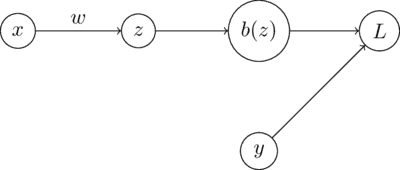Introduction
The perceptron learning algorithm is a parametric method for binary classification that is widely known as the precursor to neural networks. The computation graph below shows how the model works. The dot product of input and weight vector is taken and input into the binary step function .
Learning
Given data set of size with dimensions, parameters are learned using the perceptron learning rule. Because is almost always zero, the update rule is not defined in the way we defined the update for the logistic regression weight update rule.
Code
Code for a Perceptron classifier is shown in the block below
from typing import List
from tqdm import trange
import torch
def BinaryStep(x: torch.Tensor) -> torch.Tensor:
""" Apply binary step function to tensor
Args:
x: input tensor
Returns:
tensor with binary step function applied to all members
"""
x[x >= 0] = 1
x[x < 0] = 0
return x
def ErrorRate(y: torch.Tensor, yhat: torch.Tensor) -> float:
""" Calculate error rate (1 - accuracy)
Args:
y: true labels
yhat: predicted labels
Returns:
error rate
"""
return torch.sum((y != yhat).float()) / y.shape[0]
class Perceptron:
def __init__(self):
""" Instantiate perceptron classifier
"""
self.w = None
self.calcError = ErrorRate
def fit(self, x: torch.Tensor, y: torch.Tensor, alpha: float=0.001, epochs: int=100) -> None:
""" Fit perceptron classifier to dataset
Args:
x: input data
y: input labels
alpha: alpha parameter for weight update
epochs: number of epochs to train
"""
self.w = torch.rand((1, x.shape[1]))
epochs = trange(epochs, desc='Error')
for epoch in epochs:
for ridx in range(x.shape[0]):
hz = self.predict(x[ridx][None, :])[0]
dw = self.calcPerceptronUpdate(x[ridx][None, :], hz, y[ridx])
self.w = self.w + alpha * dw
ypred = self.predict(x)
error = ErrorRate(y, ypred)
epochs.set_description('Err: %.4f' % error)
def predict(self, x: torch.Tensor):
""" Predict labels
Args:
x: input data
Returns:
labels for each member of input
"""
z = torch.einsum('ij,kj->i', x, self.w)
hz = BinaryStep(z)[:, None]
return hz
def calcPerceptronUpdate(self, x: torch.Tensor, hx: torch.Tensor, y: torch.Tensor) -> torch.Tensor:
""" Calculate perceptron update
Args:
x: input data
y: input labels
hx: predicted labels
Returns:
tensor of weight update values the same size as weights
"""
return (y - hx) * x
Resources
- Russell, Stuart J., et al. Artificial Intelligence: A Modern Approach. 3rd ed, Prentice Hall, 2010.
